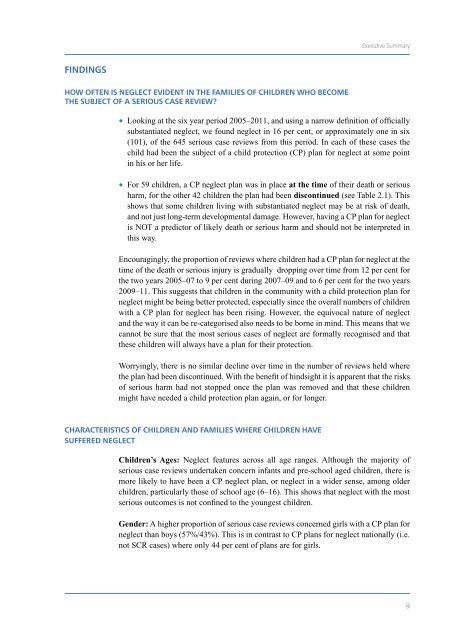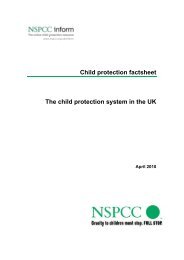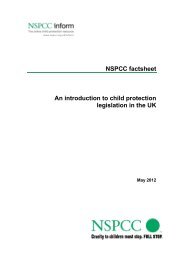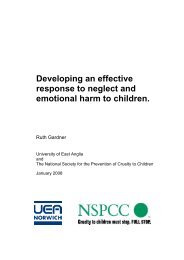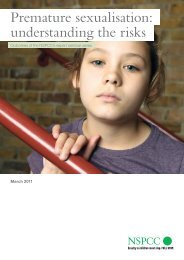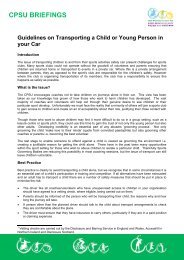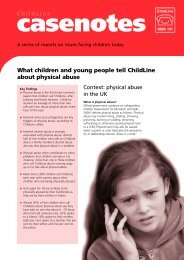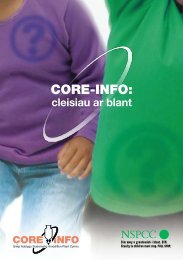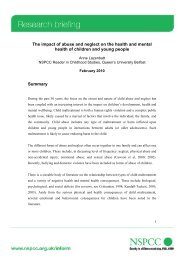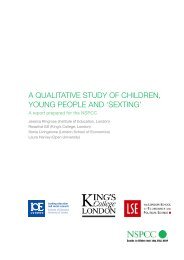Neglect and serious case reviews (PDF, 735KB) - nspcc
Neglect and serious case reviews (PDF, 735KB) - nspcc
Neglect and serious case reviews (PDF, 735KB) - nspcc
You also want an ePaper? Increase the reach of your titles
YUMPU automatically turns print PDFs into web optimized ePapers that Google loves.
fiNdiNgS<br />
how ofteN iS <strong>Neglect</strong> evideNt iN the familieS of childreN who become<br />
the Subject of a SeriouS caSe review?<br />
• Looking at the six year period 2005–2011, <strong>and</strong> using a narrow definition of officially<br />
substantiated neglect, we found neglect in 16 per cent, or approximately one in six<br />
(101), of the 645 <strong>serious</strong> <strong>case</strong> <strong>reviews</strong> from this period. In each of these <strong>case</strong>s the<br />
child had been the subject of a child protection (CP) plan for neglect at some point<br />
in his or her life.<br />
• For 59 children, a CP neglect plan was in place at the time of their death or <strong>serious</strong><br />
harm, for the other 42 children the plan had been discontinued (see Table 2.1). This<br />
shows that some children living with substantiated neglect may be at risk of death,<br />
<strong>and</strong> not just long-term developmental damage. However, having a CP plan for neglect<br />
is NOT a predictor of likely death or <strong>serious</strong> harm <strong>and</strong> should not be interpreted in<br />
this way.<br />
Encouragingly, the proportion of <strong>reviews</strong> where children had a CP plan for neglect at the<br />
time of the death or <strong>serious</strong> injury is gradually dropping over time from 12 per cent for<br />
the two years 2005–07 to 9 per cent during 2007–09 <strong>and</strong> to 6 per cent for the two years<br />
2009–11. This suggests that children in the community with a child protection plan for<br />
neglect might be being better protected, especially since the overall numbers of children<br />
with a CP plan for neglect has been rising. However, the equivocal nature of neglect<br />
<strong>and</strong> the way it can be re-categorised also needs to be borne in mind. This means that we<br />
cannot be sure that the most <strong>serious</strong> <strong>case</strong>s of neglect are formally recognised <strong>and</strong> that<br />
these children will always have a plan for their protection.<br />
Worryingly, there is no similar decline over time in the number of <strong>reviews</strong> held where<br />
the plan had been discontinued. With the benefit of hindsight it is apparent that the risks<br />
of <strong>serious</strong> harm had not stopped once the plan was removed <strong>and</strong> that these children<br />
might have needed a child protection plan again, or for longer.<br />
characteriSticS of childreN aNd familieS where childreN have<br />
Suffered <strong>Neglect</strong><br />
Executive Summary<br />
Children’s Ages: <strong>Neglect</strong> features across all age ranges. Although the majority of<br />
<strong>serious</strong> <strong>case</strong> <strong>reviews</strong> undertaken concern infants <strong>and</strong> pre-school aged children, there is<br />
more likely to have been a CP neglect plan, or neglect in a wider sense, among older<br />
children, particularly those of school age (6–16). This shows that neglect with the most<br />
<strong>serious</strong> outcomes is not confined to the youngest children.<br />
Gender: A higher proportion of <strong>serious</strong> <strong>case</strong> <strong>reviews</strong> concerned girls with a CP plan for<br />
neglect than boys (57%/43%). This is in contrast to CP plans for neglect nationally (i.e.<br />
not SCR <strong>case</strong>s) where only 44 per cent of plans are for girls.<br />
9


